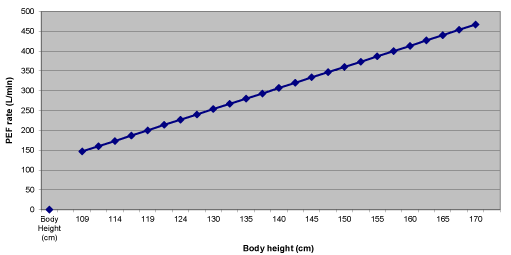Open Journal of Asthma
Calculation of Predicted Peak Expiratory Flow in Children with a Formula
Matjaž Kopač*
Cite this as
Kopač M (2017) Calculation of Predicted Peak Expiratory Flow in Children with a Formula. Open J Asthma 1(1): 007-008. DOI: 10.17352/oja.000002Background: To determine whether a child has asthma exacerbation, we should obtain the value of peak expiratory flow. It is useful in a diagnostic procedure, in evaluation of response to therapy and following the course of asthma.
The context and purpose of the study: On the basis of published relations between body height and peak expiratory flow in children I developed a formula for calculation of predicted peak expiratory flow in children according to body height.
Results: Formula for estimation of predicted peak expiratory flow in children according to body height reads as follows:
Peak expiratory flow [L/min] = (Body height [cm] x 5.3) – 433.
Conclusions: In some situations, especially in emergency settings, the presented formula may prove useful in predicting peak expiratory flow knowing only a child’s body height.
Abbreviations
PEF: Peak Expiratory Flow
Introduction
The peak expiratory flow (PEF) is defined as the maximum flow rate generated during a forced expiratory maneuver. It is effort dependent and insensitive to small airway function. It is useful in a diagnostic procedure, in evaluation of response to therapy and following the course of asthma. It is important to compare the value of measured PEF to the previous personal best value [1,2]. Most children older than five years can measure PEF by using one of several available peak flow meters. Reproducibility of the results depends on the patient’s ability to take in a full breath and exhale rapidly with maximum force [3].
Available literature provides normal values for lung function tests in children, including PEF rates. A study was carried out in normal children, aged 5 to 18 years, and according to those measurements, nomograms for predicting lung function values (including PEF) according to height were made and published [4]. Relations showing predicted average PEF rates for normal children according to body height are published in the form of tables and presented in Figure 1 [1,2].
Methods
On the basis of published relations between body height and PEF rates in children, a diagram representing these data is shown in figure 1 [1,2]. As can be seen from the diagram, these relations are linear and a correlation coefficient between body height and PEF is 1. Therefore a predicted average PEF in children according to body height could be presented with a formula by using a concept of linear regression: predicted average PEF [L/min] = (Body height [cm] x k) + n. In this equation factor k is a regression coefficient, representing a slope of the curve in the diagram. It can be obtained by dividing a value on y-axis (PEF axis) by a corresponding value on x-axis (Body height axis) as follows: . By inserting several different values in the equation and then calculating an average, we get the value of factor k to be 5.3. A value n can then be obtained by solving a simple equation by inserting corresponding values: n= PEF [L/min] - (Body height [cm] x 5.3). By inserting several different values of body height and then calculating the average, we obtain the value n to be - 433.
Results
According to above mentioned relations between body height and PEF, a formula that can be used to calculate predicted average PEF in children according to body height is presented hereby and reads as follows:
Predicted average PEF [L/min] = (Body height [cm] x 5.3) – 433
For example, if a child’s body height is 157 cm, the predicted average PEF (in L/min) is: 157 x 5.3 – 433 = 832.1 – 433 = 399.1. We can insert different values of body height (valid in children, higher than about 110 cm), thus obtaining appropriate results.
Discussion
Measurement of PEF is one of the basic and quite simple pulmonary function tests. Objective measurement of pulmonary function is useful in the diagnostic procedure of children with respiratory symptoms as well as in monitoring the current status and therapeutic response of a child with asthma. They are valuable only if accurate and interpreted appropriately. In adition, serial measurements over time are more helpful than isolated measurements. It is also very important to compare the value of measured PEF to the previous personal best value [3]. But since children grow constantly, knowing the personal best value may be sometimes misleading, especially after a stable period of asthma without exacerbations. A child’s personal best value of PEF one or two years ago may be below the predicted PEF value for present body height. In this way asthma exacerbation may be overlooked. Constant evaluation of PEF according to body height is necessary in chronic respiratory diseases, such as asthma. Nomograms and tables are available that help us to predict PEF in a child but they are not always available when we need them, especially in emergency settings. In these situations the presented formula may prove useful in predicting a child’s PEF knowing only body height. Values of PEF obtained by the presented formula differ from values presented in published tables by no more than 1 % which is not clinically significant. Of course the formula can be used only in children above five years of age who are able to perform the PEF test. Fortunately, the relations between predicted average PEF rates in children according to body height are linear which makes the presented formula relatively simple and easy to remember.
Conclusions
Measurement of PEF is one of the basic and quite simple pulmonary function tests.
Constant evaluation of PEF according to body height is necessary in chronic respiratory diseases, such as astma. Nomograms and tables are available that help us to predict PEF in a child but they are not always available when we need them, especially in emergency settings. In these situations the presented formula may prove useful in predicting a child’s PEF knowing only a body height. To the best of my knowledge, the presented formula is the first published formula for estimation of PEF in children according to body height.
- Loughlin CE (2005) Pulmonology, V. Pulmonary Function Tests, A. Peak Expiratory Flow Rate. In: The Harriet Lane Hanbook, 17th ed. Edited by Robertson J, Shilkofski N, Philadelphia: Elsevier Mosby, 619-620. Link: https://goo.gl/cKPXKD
- Kirk A (2012) Pulmonology, IV. Pulmonary Function Tests, A. Peak Expiratory Flow Rate. In: The Harriet Lane Hanbook, 19th edn. Edited by Tschudy MM, Arcara KM, Philadelphia: Elsevier Mosby, 586-588. Link: https://goo.gl/TMLtKf
- Voter KZ, McBride JT (1996) Diagnostic Tests of Lung Function. Pediatr Rev 17: 53-63. Link: https://goo.gl/jqBVV7
- Godfrey S, Kamburoff PL, Nairn JR (1970) Spirometry, lung volumes and airway resistance in normal children aged 5 to 18 years. Brit J Dis Chest 64: 15-24. Link: https://goo.gl/k1wZT3

Article Alerts
Subscribe to our articles alerts and stay tuned.
 This work is licensed under a Creative Commons Attribution 4.0 International License.
This work is licensed under a Creative Commons Attribution 4.0 International License.

 Save to Mendeley
Save to Mendeley
